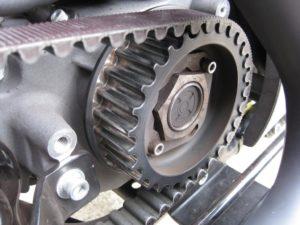In the beginning there was the belt drive.
The timing belt transmission is fairly recent. Once secondary transmission started as a leather belt. A leather belt - which is under tension, because he was only too happy to slip - formed the connection between the crankshaft and the rear wheel. It was. Then came the sleeve and roller chains that performed reasonably well with adequate maintenance until the moment that engines received more than 50 hp. With the 67 horsepower of the CB 750 the stretch was really out for those things. Fortunately the O-ring chain was invented. And then came the timing belt transfer.
In 1979, Kawasaki thought that power could also be transferred via timing belts.
Kawa presented that idea on the LTDs, cuddly custompjes. With the eyes of today, those things don't look. Just to be clear: there are V-belts and timing belts. When it comes to the drive of two-wheelers, we find V-belts as a transmission device for the scooters in the variator. Such a V-belt needs a certain pre-tension and transmits the power through its flanks. Timing belts are used for driving rear wheels. So it was in 1979 that Kawasaki (and Harley-Davidson) started using timing belts to drive the rear wheels of motorcycles. Those timing belts became commonplace at Harley-Davidson and Buell, and the BMW 650 single-pits got such a secondary drive.
The contact voltage
A toothed belt must have a certain contact tension to prevent the teeth of the belt from jumping over the teeth of the pulley. That pre-tension is at the level of the highest tensile force that occurs in the toothed belt in the first gear. The advantage of this pre-tensioning is that there is no play in the drive to the rear wheel. After braking on the engine, there is therefore no jerk in the drive when gas is given again. The phenomenon even limits the wear on the rear tire. That is a bonus. That 'punching-out play pressure' is the case with a chain. Even more pluses: a toothed belt is silent and maintenance-free. Only a regular wipe and an inspection to detect damage is required.
A high return
What has been established is that the toothed belt has a higher efficiency than a modern O-ring chain, which keeps the grease 'inside' the chain. If the outside of such an O-ring chain is not properly lubricated, it requires drive power because the friction between the rollers and the sprockets increases. That can cost 1,5 kW power! A well-lubricated chain loses 0,9 kW and the timing belt only 0,6 kW. And for the Old School riders: Multiply those values with 1,36 to get the numbers of horsepower.
And some drawbacks
There are, of course, also disadvantages associated with toothed belts relative to drive chains. It is not easy to set and maintain the pre-tension, which is why Buell releases it with a tensioner. The pulleys are large with a toothed belt to keep the tension in the belt low. As a result, the timing belt transmission is not as suitable as a chain if the motorcycle is very fast. Up to such an 160 km / h it works fine. Driving with an open toothed belt is good for cooling, but in theory less good for wear.
The wear is not too bad
Fortunately, the latter turns out to be not too bad on our road network in practice. The service life of a good O-ring chain can also be achieved with a toothed belt. We then talk about such an 40.000 km. And after the run-in period, such a toothed belt with its steel or plastic fiber reinforcement.






40000km with a belt? We have several motorcycles driving around the club that have made a ton with their belt. Harley itself gives up 60-80 K to replace the belt. Doesn't matter with that o ring necklace
In the late 50s, early 60s JLO already used the timing belt as primary drive in the 50cc blocks, the so-called “Piano” blocks.
So as a transmission between the crankshaft and the 2- or 3-speed gearbox.
Hans Glas was the first to use the toothed timing belt in the Glas 1004. That was in 1961, so now about 56 years ago. https://en.wikipedia.org/wiki/Glas_1004